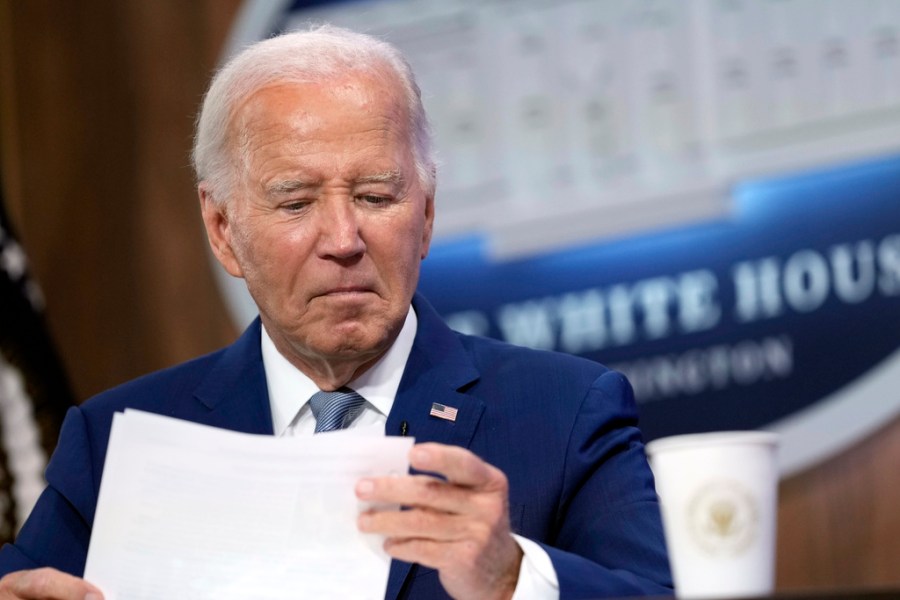Just In News
Shortly after the Russian attack on Kharkiv Monday morning, the U.S. ambassador to Ukraine, Bridget Brink, posted on X that “Russia attacked Ukrainian civilians today in Kharkiv with ballistic missiles and aerial glide bombs. Forty-four people were injured, including seven children due to start school tomorrow. The U.S. condemns this and every attack on Ukraine by Russia.”
The attack on Monday involved a mix of 35 missiles and 23 drones, all fired from within Russia — from Bryansk, Voronezh, Kursk, Volgograd, and Belgorod Oblasts.
The previous week, President Biden had provided a statement about a similar Russian attack on Ukrainian civilians. “I condemn, in the strongest possible terms, Russia’s continued war against Ukraine,” Biden said. “Let me be clear: Russia will never succeed in Ukraine, and the spirit of the Ukrainian people will never be broken….The United States will stand with the people of Ukraine until they prevail.”
What Biden and National Security Advisor Jake Sullivan seemingly fail to comprehend is that Ukraine will never prevail if it cannot fight back.
“Weaken Russia” and defend are not strategies that will allow Ukraine to prevail — only strategies that afford Russia the initiative and virtually guarantee more days like Aug. 26, Sept. 2 and now Sept. 3, when 41 Ukrainians were killed and another 180 injured in a Russian missile strike on the city of Poltava.
Karel Rehka, chief of the general staff of the Czech Armed Forces, said it best, “If we want Ukrainians to prevail, we have to let them bring the war to the Russian territory.”
Would someone please tell the president? The Ukrainian civilian population has become the bill payer.
Condemnation does not stop the bombing. Neither have the air defense weapons sent to protect Ukrainian citizens. Shooting missiles, glide bombs and drones out of the sky is not the solution — destroying the weapon system and all their associated enablers (crews, radars, ammunition storage facilities, command and control networks) is the solution.
Ukraine needs deeds, not words. This begins with a release of restrictions on Ukraine striking Russian targets that present a clear and imminent threat, regardless of their physical location, with weapons provided by the U.S. and NATO. That means letting the Ukrainians use ATACMS, Storm Shadow, SCALP, F-16 fighter jets and whatever other weapon systems Ukraine deems necessary to strike Russian targets within Russia.
That is the same policy afforded to U.S. Central Command in the Middle East, where they routinely determine the Houthi weapon systems they destroy in Yemen to “present a clear and imminent threat to U.S. and coalition forces, and merchant vessels in the region.”
Biden should also consider the bipartisan proposal presented by Sens. Lindsey Graham (R-S.C.) and Richard Blumenthal (D-Conn.) to authorize retired pilots from the NATO alliance and the U.S. to be hired by Ukraine to fly their newly acquired F-16 fighter jets, defending Ukrainian skies and providing close air support to ground forces.
There is historical precedent — the American Volunteer Group, also known as the Flying Tigers, were American pilots and ground crews, former members of the U.S. Armed Forces, recruited to fight on contract for the Chinese Air Force against the Japanese. Their service in that capacity was memorialized in a 1942 movie starring John Wayne.
Ukrainian President Volodymyr Zelensky has a plan to win the war, and he is bringing that plan with him to New York when he attends the 79th Session of the United Nations General Assembly this month. The question is whether anyone in the Washington establishment will embrace it.
He is slated to present the plan to President Biden and the two presidential candidates, Vice President Kamala Harris and former President Donald Trump.
The Biden administration’s persistent need to examine, re-examine and consider Ukrainian requests over the last 31 months has repeatedly given Russia time to react, and now reposition, upwards of “90 percent of the aircraft that conduct glide bomb strikes from Russian airspace away from airfields within range of Storm Shadow and ATACMS missiles,” according to the Institute for the Study of War.
As retired Lt. Gen. Ben Hodges, former commander of U.S. Army-Europe, has stated, “This terrible policy, which actually protects Russian airfields better than it protects Ukrainian civilians, is a manifestation of the fact that we don’t have a clearly defined objective.”
Although the Russians have moved “some targets” out of range, there are at least 250 military and paramilitary targets in Russia that remain within range of the ATACMS missiles provided by the U.S.
Targets beyond the range of ATACMS can be struck by Ukrainian-made weapons. The Palianytsia missile-drone, described by Andrii Kharuk as a lightweight cruise missile, has a range between 300 and 450 miles. It was recently used to strike the Savasleyka military airbase, located nearly 413 miles from the Ukrainian border, destroying a MiG-31K and two Il-76 aircraft.
Former NATO Commander and retired Air Force Gen. Philip Breedlove accurately summarized the situation Biden has created: “This war is going to end exactly how Western policymakers decide it will end. If we keep doing what we’re doing, Ukraine will eventually lose. Because right now….we are purposely not giving Ukraine what they need to win.”
The speed of Biden has been detrimental to Ukraine’s ability to prevail on the battlefield. Biden has one last opportunity, as he often states, to be “on the right side of history.” He must lift restrictions on Ukraine’s use of U.S. and NATO supplied long-range weapons and allow them to strike the list of targets they presented to senior officials in Washington last week.
Col. (Ret.) Jonathan Sweet served 30 years as a military intelligence officer. Mark Toth writes on national security and foreign policy.
National Security, Opinion Read More
Author Profile
Latest entries
 HeadlinesSeptember 18, 2024Fun Facts: You would have to click a computer mouse 10 million times to burn a single calorie
HeadlinesSeptember 18, 2024Fun Facts: You would have to click a computer mouse 10 million times to burn a single calorie ScienceSeptember 18, 2024Breast milk antibodies protect against rotavirus
ScienceSeptember 18, 2024Breast milk antibodies protect against rotavirus HeadlinesSeptember 18, 2024Top 5 Diddy indictment bombshells: What legal experts predict for future of fallen music mogul
HeadlinesSeptember 18, 2024Top 5 Diddy indictment bombshells: What legal experts predict for future of fallen music mogul ScienceSeptember 18, 2024Low levels of 1 mineral can make IBD worse
ScienceSeptember 18, 2024Low levels of 1 mineral can make IBD worse

